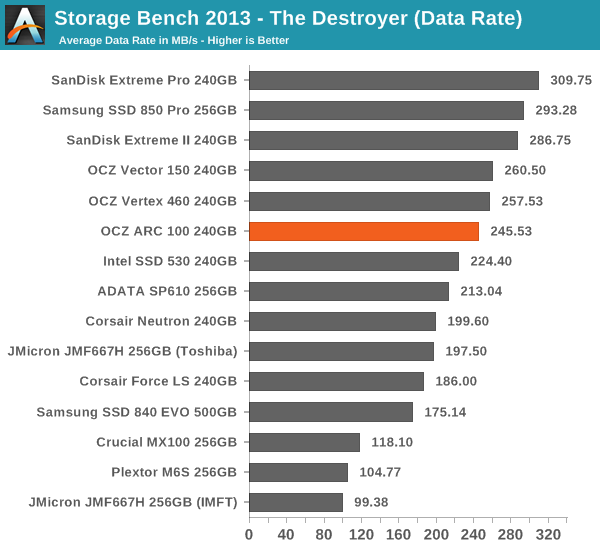OCZ ARC 100 (240GB) SSD Review
by Kristian Vättö on August 26, 2014 7:00 AM ESTAnandTech Storage Bench 2013
Our Storage Bench 2013 focuses on worst-case multitasking and IO consistency. Similar to our earlier Storage Benches, the test is still application trace based – we record all IO requests made to a test system and play them back on the drive we are testing and run statistical analysis on the drive's responses. There are 49.8 million IO operations in total with 1583.0GB of reads and 875.6GB of writes. I'm not including the full description of the test for better readability, so make sure to read our Storage Bench 2013 introduction for the full details.
| AnandTech Storage Bench 2013 - The Destroyer | ||
| Workload | Description | Applications Used |
| Photo Sync/Editing | Import images, edit, export | Adobe Photoshop CS6, Adobe Lightroom 4, Dropbox |
| Gaming | Download/install games, play games | Steam, Deus Ex, Skyrim, Starcraft 2, BioShock Infinite |
| Virtualization | Run/manage VM, use general apps inside VM | VirtualBox |
| General Productivity | Browse the web, manage local email, copy files, encrypt/decrypt files, backup system, download content, virus/malware scan | Chrome, IE10, Outlook, Windows 8, AxCrypt, uTorrent, AdAware |
| Video Playback | Copy and watch movies | Windows 8 |
| Application Development | Compile projects, check out code, download code samples | Visual Studio 2012 |
We are reporting two primary metrics with the Destroyer: average data rate in MB/s and average service time in microseconds. The former gives you an idea of the throughput of the drive during the time that it was running the test workload. This can be a very good indication of overall performance. What average data rate doesn't do a good job of is taking into account response time of very bursty (read: high queue depth) IO. By reporting average service time we heavily weigh latency for queued IOs. You'll note that this is a metric we have been reporting in our enterprise benchmarks for a while now. With the client tests maturing, the time was right for a little convergence.

The good IO consistency translates into good performance in our 2013 Storage Bench. The ARC 100 is without a doubt the fastest value drive in the market for heavy IO workloads as the 840 EVO and MX100 do not even come close.











54 Comments
View All Comments
StevoLincolnite - Tuesday, August 26, 2014 - link
That's true to an extent.I have an OCZ Vertex 2 64Gb SSD which has been fantastically solid for years, if it died and I was able to get it replaced under warranty, I would throw it into a notebook and use the excuse to upgrade the SSD in my main desktop.
That said, the main benefit of an SSD over mechanical that an end-user will notice is not actually the read/write speeds, but rather the 0-latency access times which makes everything feel super snappy and responsive, improved reads/writes are just diminishing returns from an end users experience perspective, hence why I have kept my old Vertex 2 for so long.
hurleydood - Wednesday, December 31, 2014 - link
My old 128GB patriot SSD had a 10 year warranty, failed in 5 years. Patriot replaced it with a latest 240GB SSD they had in inventory. So expect replacements to be current spec.Kristian Vättö - Tuesday, August 26, 2014 - link
Only the 120GB Extreme II is cheaper than the ARC 100 and both have the same 3-year warranty. The Extreme Pro has a 10-year warranty but it is much more expensive.Samus - Tuesday, August 26, 2014 - link
The Extreme II is actually more expensive at all price points except the minimum capacity (120GB) and it isn't always faster, either. The only reason to consider it is for a laptop (where Barefoot 3 makes no sense) if price is a concern.However, I don't see any reason to get anything other than an MX100 for anything except high-performance applications. SleepDev, OPAL, PLP capacitors, solid reliability, lowest price of any SSD at mainstream capacities, and so on...
miandrew - Tuesday, August 26, 2014 - link
Great article. I noticed that the SanDisk Extreme II consistently beats the OCZ ARC 100 and it has slumber power which helps in the laptop world. Nice that Newegg currently has the OCZ sale. So many choices...jerrylzy - Tuesday, August 26, 2014 - link
Why there's no trim validation now?Kristian Vättö - Tuesday, August 26, 2014 - link
I don't usually test TRIM anymore unless we are dealing with a new controller/firmware platform. The Barefoot 3 platform has shown to offer functional TRIM.Witchunter - Tuesday, August 26, 2014 - link
I read this like so: http://i.imgur.com/CMcHBs7.jpg.I agree that there's no need to test it again, but perhaps a reference could be helpful?
Kristian Vättö - Tuesday, August 26, 2014 - link
Haha, a reference sounds like a good idea. I've been trying to streamline the review process to get through my backlog quicker, so that is why it might seem like I'm cutting corners, but I'll take this into account :)Prodromaki - Tuesday, August 26, 2014 - link
Kris, Samsung EVO 256 doesn't cost that much. Its newegg price is 140$. In EU(amazon) for some weird reason MX100 and the EVO are almost the same price(130$ vs 140$). Furthermore the Arc 100 costs ~160$, which definitely makes it a way worse buy than the two other value choices over here.